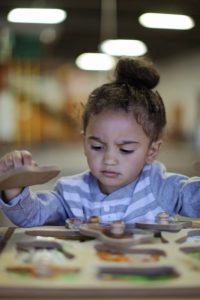Puzzles & Development

Puzzles are great for child development.
- First, you’ll want to set up in an area with minimal distractions, such as a quiet corner away from other toys. We want to work up to the child being able to sit down and complete an entire puzzle without getting up or grabbing other toys. Choose a puzzle with familiar objects like animals, vehicles, food, etc. I’ve attached pictures of a few examples that would work below.
- You can either empty the puzzle yourself or have the child take each piece out and give to you one at a time (another way to work on following directions). Point to a puzzle piece and say “Pick up”. When child picks it up, open your hand and say “Give to me”. Make sure child is picking up the one you are telling her to pick up to help them understand how to follow the directions
- Take control of all the pieces by hiding them behind your back or putting them in a pocket so the child cannot grab them all at once.
- Hold two puzzle pieces in front of the child, let’s say for example an apple and a banana.
- Tell the child to find one of them. So for our example, you could say “Find the apple” “where’s the apple” or “show me apple”. Try to use short sentences to tell the child what you want them to do. Try to stick to 3 words or less when you ask her to do something. This will help her start to understand all the words you are saying. If we say too many words, she may get overwhelmed and not necessarily listen to what you’re asking.
- If you say “find apple” then make sure she chooses apple. If he/she starts to reach for the banana, pull it back towards you out of their reach and say “no that’s banana”. If he/she is still struggling to choose the right one, you can put the correct puzzle piece closer to her so it’s easier to reach, or you can even help her choose the right one by helping her grab the correct one. If you say apple but he/she chooses the banana because that’s the one he/she may want, we are defeating the purpose of the task and he/she may start to confuse apple and banana. If you tell them to find a certain puzzle piece, make sure he/she is following through with the direction and chooses the correct one.
- Once he/she chooses the right one, give her some praise and say “yes, that’s apple!”. This positive encouragement will help them understand the label with the picture, as well as motivate her to try again.
- Then, you can help put the puzzle piece in the right spot.
- Continue showing the two objects and telling her to find one until you only have one piece left. If she is trying to reach for the last one and seems like she wants to finish it, you can see if she will sign “more” for the last piece.
https://www.youtube.com/watch?v=ceWE0vhbc-Q
- This video describes receptive language and shows how to use two puzzle pieces to target these skills
Choose puzzles with objects that you think she knows some or most of the pieces. This will help your child learn new words and give her more success to help build her confidence.
Developmental Checklist
Is your child meeting their developmental milestones?
 Skip to content
Skip to content